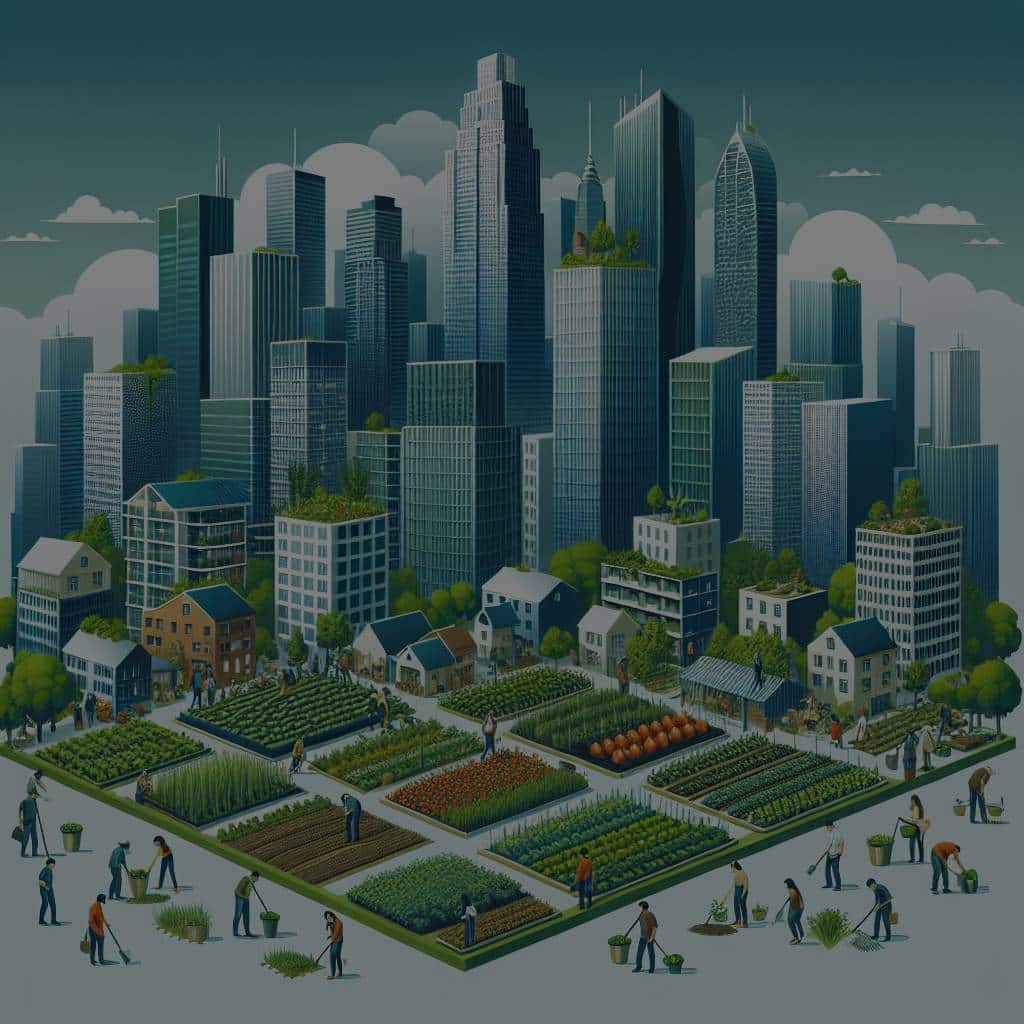What Role Can Real Estate Play in Urban Agriculture and Food Security?

With urbanization and population growth taking a toll on agricultural land and food security, the need for innovative solutions has never been so urgent. One such solution lies in the realm of real estate, which can provide a canvas for sustainable urban agriculture. As cities grow, the demand for fresh, locally sourced produce is increasing. Here, real estate can play a pivotal role in meeting this demand by integrating agriculture within the urban fabric.
The Interplay Between Urban Agriculture and Real Estate
The connection between urban agriculture and real estate is a dynamic, fascinating one. It’s not just about growing food in cities. It’s about how properties, unused lands, rooftops, and even vacant lots can be converted into productive spaces.
Sujet a lire : How to Utilize Geothermal Heating in Residential Real Estate Developments?
Transforming Spaces into Urban Farms
Urban farming is a game-changer in the world of agriculture. By cultivating crops or rearing animals within and around cities, it provides fresh food, reduces food miles, and contributes to local economies. Real estate plays a crucial role in the development of these urban farms. Unused spaces in cities, such as vacant lots, rooftops, and even abandoned buildings, can be transformed into thriving green spaces.
Urban farms can be as simple as community gardens, where local residents come together to grow food, or as complex as vertical farms in high-rise buildings, using advanced technologies like hydroponics and aquaponics. Real estate developers, landowners, and city planners have the power and the responsibility to allocate land and resources for these initiatives that champion sustainability and food security.
Dans le meme genre : What Is the Impact of Autonomous Vehicle Technology on Future Real Estate Planning?
The Role of Green Architecture
Green architecture is another intersecting point where real estate converges with urban agriculture. It is a design approach that seeks to mitigate the environmental impact of buildings while improving their efficiency and sustainability.
Green roofs and walls, also known as living architecture, are increasingly being incorporated into building designs. These spaces not only enhance the aesthetic appeal of buildings but also serve as platforms for urban farming. By cultivating plants on rooftops and walls, buildings can produce their own food, reduce the heat island effect, and improve air quality. Here, real estate developers play a key role in promoting and implementing these green design practices.
The Impact of Urban Agriculture on Food Security
Urban agriculture has a direct and significant impact on food security. It contributes to the availability, access, and use of food, particularly in urban settings where access to fresh produce can be challenging.
Enhancing Local Food Systems
By producing food within cities, urban agriculture enhances local food systems. It shortens the supply chain, ensuring that food reaches consumers faster and fresher. This not only improves the nutritional quality of food but also reduces the carbon footprint associated with long-distance transportation of food.
Through urban agriculture, real estate can support local food systems. By providing spaces for urban farms, real estate can help increase the availability of fresh, locally grown food. It can also create opportunities for direct marketing, such as farmers’ markets and community-supported agriculture programs, which give consumers direct access to local produce and support local farmers.
Promoting Food Sovereignty
Urban agriculture also promotes food sovereignty, which is the right of people to access healthy and culturally appropriate food produced through sustainable methods.
In many cities, food deserts—areas with limited access to affordable and nutritious food—are a major concern. Urban farms can help address this issue by providing local, affordable, and healthy food options. Real estate can contribute to this effort by providing land and infrastructure for urban farms, particularly in underserved neighborhoods.
The Business Case for Real Estate in Urban Agriculture
While the environmental and social benefits of urban agriculture are clear, there is also a strong business case for real estate to invest in this sphere.
Attracting Socially-Conscious Tenants and Buyers
Today’s consumers are increasingly conscious about sustainability. They are willing to pay a premium for properties that align with their values. By integrating urban agriculture into their projects, real estate developers can attract these socially-conscious tenants and buyers.
For instance, residential buildings with community gardens or commercial spaces with green roofs not only offer unique selling points but also foster a sense of community and wellbeing among occupants. These features can give real estate properties a competitive edge in the market.
Boosting Property Value
Urban agriculture can also boost property value. Properties with green features, such as green roofs and walls, are often perceived as more valuable due to their aesthetic appeal and environmental benefits. Furthermore, properties located near urban farms or community gardens may enjoy higher property values due to the improved neighborhood amenity.
Urban agriculture is not just about food production. It’s about sustainability, community, and resilience. It’s about leveraging real estate to create cities that are not only livable but also edible. As we navigate the challenges of urbanization and climate change, real estate can and must play a significant role in promoting urban agriculture and ensuring food security.
Maximizing Urban Spaces for Agriculture
In today’s urbanized world, every square foot counts. Real estate developers and city planners can creatively maximize these urban spaces by integrating agriculture into the fold.
One method is through vertical farming. This is the practice of growing crops in vertically stacked layers, typically inside buildings like warehouses or specialized greenhouses. It utilizes controlled-environment agriculture (CEA) technology, which helps optimize plant growth, and soilless farming techniques such as hydroponics, aquaponics, and aeroponics. By growing upwards, vertical farming can yield more crops per square foot than traditional farming methods. This is particularly beneficial in cities where land area is limited.
Another method is through rooftop farming. Rather than leaving rooftops bare or using them solely for HVAC systems, they can be transformed into productive green spaces. Rooftop farms can produce a variety of crops, from fruits and vegetables to herbs and even honey from beehives. They provide a host of benefits, such as urban heat reduction, stormwater management, and biodiversity conservation.
There are also opportunities to transform unused urban spaces, such as vacant lots, abandoned buildings, and even parking lots, into community gardens or urban farms. These initiatives not only provide fresh produce but also engage communities and improve neighborhoods.
The Future of Real Estate and Urban Agriculture
As we move forward, real estate and urban agriculture will continue to intersect, presenting exciting opportunities for innovation and collaboration.
Real estate developers and city planners will need to think beyond the traditional boundaries of urban land use and design. They will need to incorporate green spaces, urban farms, and other elements of urban agriculture into their development plans and city ordinances. This will require a shift in mindset, from viewing real estate solely as a money-making venture to seeing it as a platform for sustainable development and food security.
Urban agriculture will also need to evolve, incorporating advanced technologies and farming techniques to increase yields, improve efficiency, and reduce environmental impact. This includes precision agriculture, which uses data and technology to optimize crop production, and circular agriculture, which seeks to close nutrient cycles and reduce waste.
As these two fields converge, they can create cities that are not only livable but also sustainable and resilient. Cities where buildings and landscapes are not just for dwelling but also for growing food. Cities that give new meaning to the term "concrete jungle".
Wrapping Up
In conclusion, real estate plays a significant role in urban agriculture and food security. It provides an infrastructure for urban farms, promotes sustainable design practices, supports local food systems, and enhances property values. By integrating urban agriculture into their projects, real estate developers can create more resilient, sustainable, and food-secure cities.
The challenges of urbanization and climate change are daunting, but they also present opportunities for innovation and transformation. As we strive to feed a growing urban population, ensure food security, and maintain ecological balance, real estate and urban agriculture will be key pieces of the puzzle.
The future of urban living lies in the intertwining of real estate and urban agriculture. As we move forward, let’s continue to explore and harness this synergy for the betterment of our cities and our planet.
